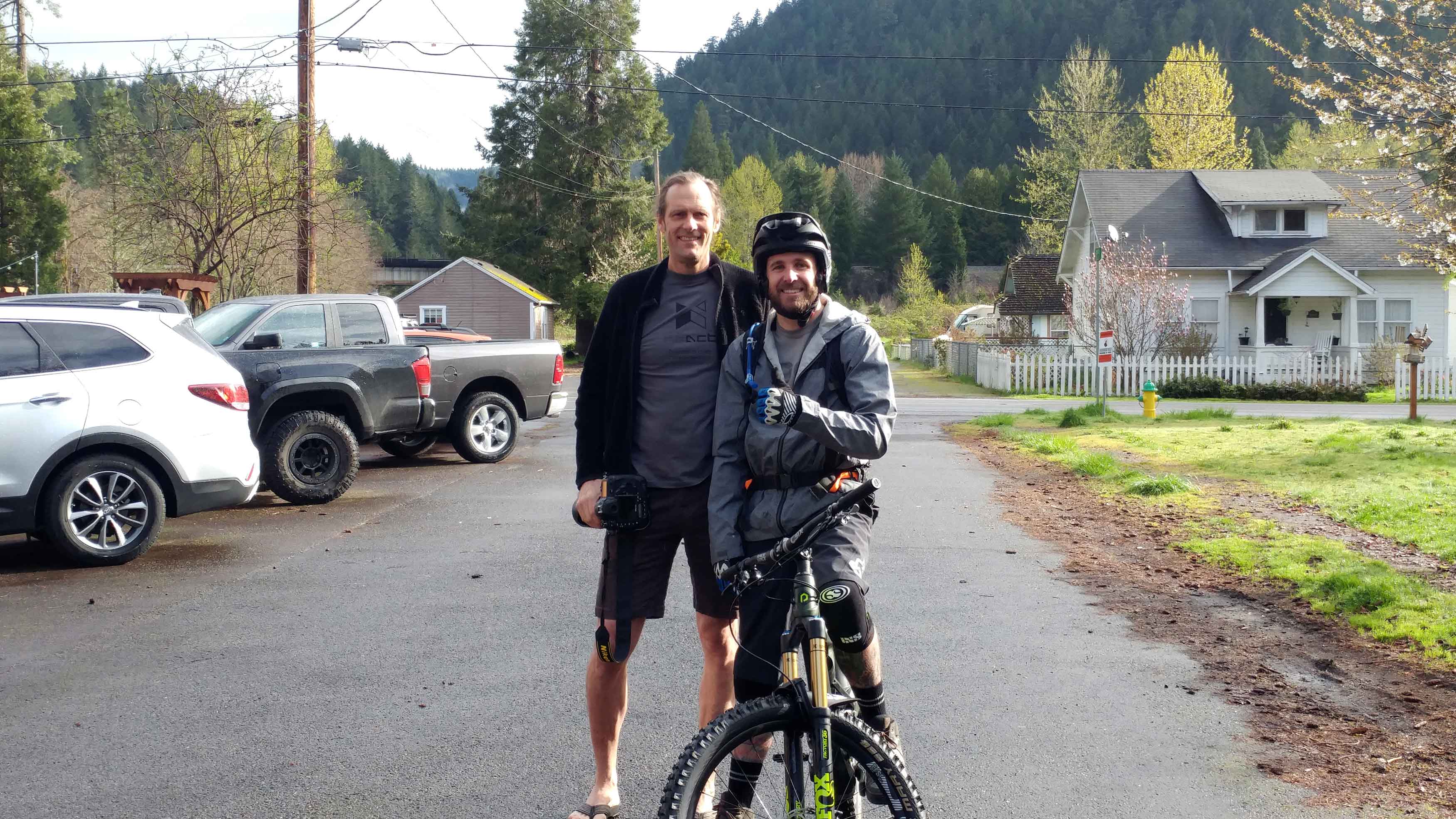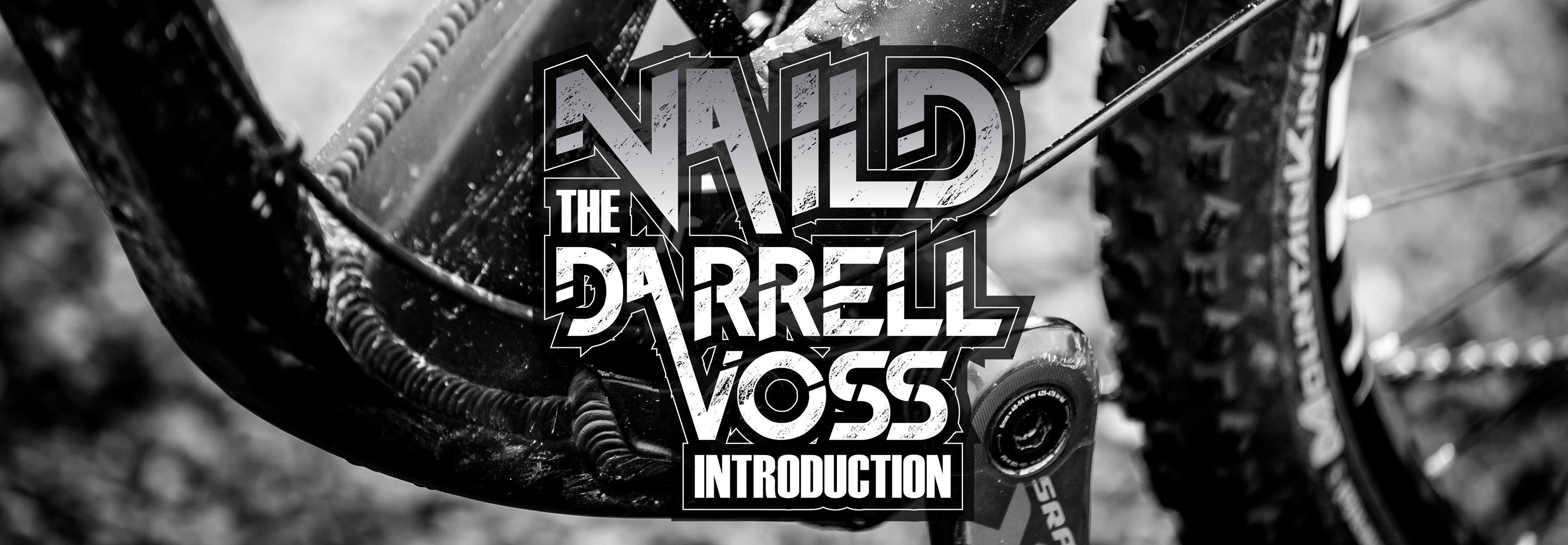
Naild: The Darrell Voss Introduction
Words by Drew Rohde // Photos by Dennis Yuroshek & Darrell Voss
After years of secret meetings and test sessions with bikes camouflaged in bubble wrap, Polygon and NAILD have released their collaborative effort to restore mountain bikes to their do it all roots. The official unveiling to this long project was a media event in Oakridge, Oregon where the first production-ready bikes would be shown to attending media and Polygon athletes, Mik Hannah and Kurt Sorge.
In one sense, the media launch was the culmination of a major life investment from Darrell Voss, NAILD’s founder. On the other hand, this weekend was only the beginning of what is sure to be a major jolt to the bike industry and a kickstart to Voss’ new brand. The R3ACT suspension system NAILD developed has been 20 years in the making and I was lucky enough to be a part of the documentation and testing for the last three years. During that time I was employed by decline magazine, however since the publication’s untimely closing, much of the work I’d taken part in was unpublished or unread. Seeing as how I truly believe this suspension platform is revolutionary and going to elevate more than just chainstays, I felt compelled to republish this story here, on The Loam Wolf.
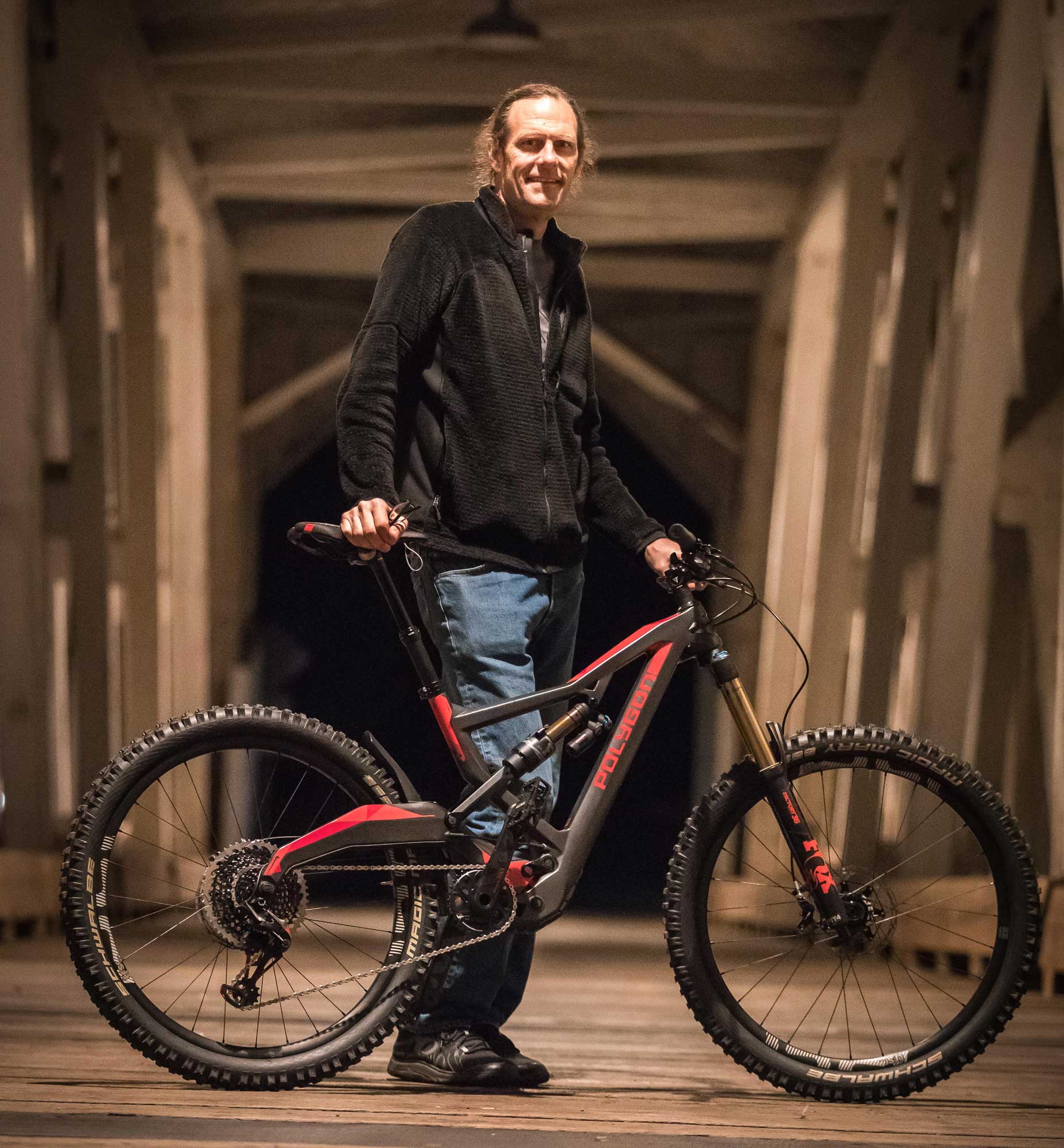
When Sasquatch heard Darrell was coming to Oakridge for the weekend, even he got scared and ran away.
Darrell Voss is a big man, and I’m not only referring to his six and a half foot stature. So when Darrell called saying he wanted me to help document the development of a revolutionary new suspension design, I didn’t really have much of an option.The pressure was on. Voss owns several patents and has a direct link to technologies still in use today yet he prefers to stay behind the scenes. Make no mistake the fact his initials aren’t blasted all over chainstays or glowing in the industry limelight isn’t because he shouldn’t be there, but because he prefers to remain anonymous, instead letting the equipment do the talking. Voss is passionate about bikes, consumer fun and trail access yet he also seems to ooze a strong distaste for the “magical fairy dust” sprinkled around by engineers and marketing companies alike. At times during our journey together I chuckled at how a seemingly cynical and unassuming genius could actually still be so motivated to deliver a product driven by his love for bikes. Throughout the course of this project he’s remained focused on producing bikes and technologies that “puts butts on bikes,” as he puts it. The bulk of Voss’s extensive career has been spent creating performance products that are affordable to the everyday rider, and with Naild he hopes to change the need for expensive or electronic shocks for a more affordable bike with superior kinematic design.
Voss started his bicycle industry love affair in the early 1980s as a BMX racer and soon transitioned to designer and engineer. From his early days as a racer and shop employee until today, Voss amassed nearly two dozen patents for bicycle related technologies, and one sweet nickname. Big Bunny, as his old friends know him, is the alias he earned by his impressive bunny hopping skills. Before making a name for himself behind the scenes he was the talent.
I’ve known Darrell for quite a while as his current role with SR Suntour kept us in contact fairly regularly, however nearly three years ago Darrell and I met for the first time to discuss his new project. We went east to the California desert and rode with Eric Carter and several engineers that flew over from Asia to unveil the first phase of this new class-killing bike. Before we get into the new technology Naild is working on, I’d like to introduce just some of the technologies Voss has been a part of bringing to our world.
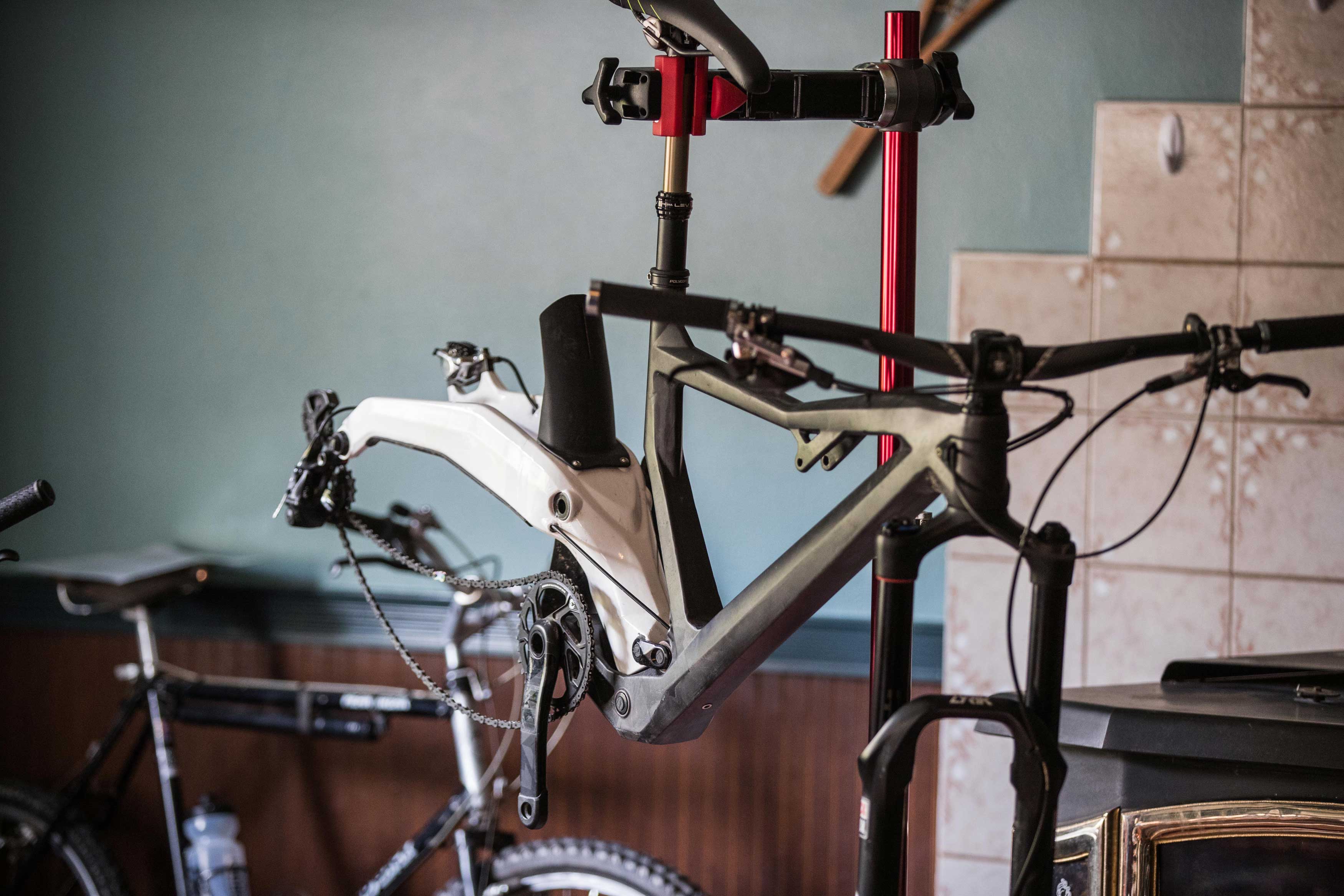
One of the first carbon prototype frames. How do you think this bike would look without a shock?
HISTORY LESSON
After the early years of racing and shop ratting, Voss landed his first industry job at Everett Manufacturing, owner of Kool Stop Intl. “Richard Everett allowed me to access the shop in the evenings and work on side projects. I was in charge of building tooling for various projects in rubber, plastic and castings by day, so this knowledge came into play during my nights of tinkering,” Voss said.
In 1984 Voss started looking for a road bike, but being six-foot seven inches tall made it difficult. “I sought out several custom frame makers and decided to work with Gary Klein as he understood what I was looking for from the structure of the frame and application,” explained Voss. “During the custom-build process we ended up having many discussions about bikes and the manufacturing process,” soon after Klein asked Voss to help make some tooling for several of his bikes. Afters everal years of working for both Everett and Klein, Voss made the full-time switch to Klein in late 1989 to support the production plant and develop engineering. A job he says was overwhelming, “I was very young and didn’t have the experience or support around me at the time; it didn’t last as long as I wished with Klein when he sold the brand to Trek in 1995. It was clear early on that there was going to be changes coming to the company and in 1996 we parted ways. I hated moving on from a brand that we worked so hard to develop into a premier bike company but it was just not a good fit for both of us,” Voss shared.
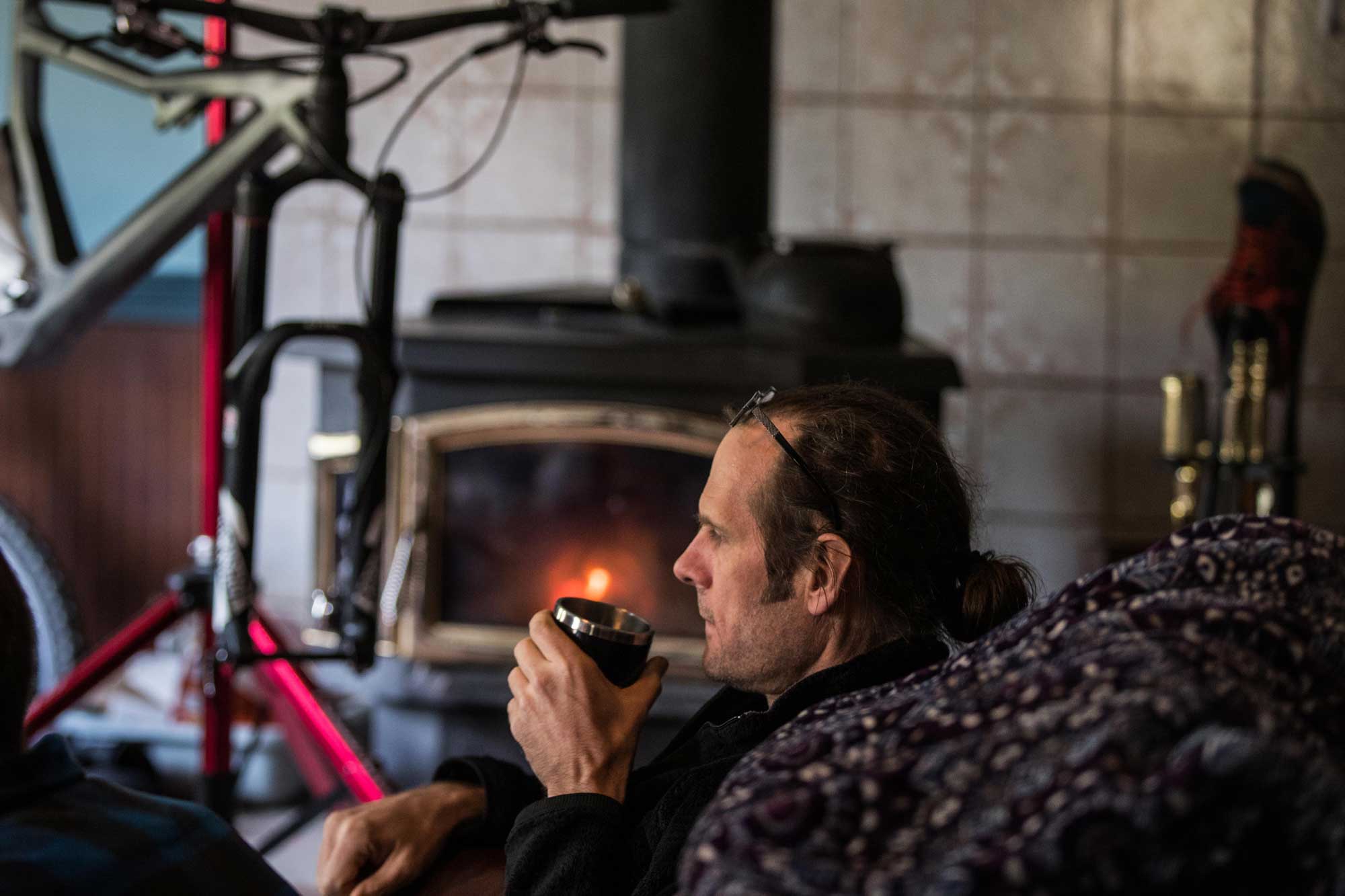
After working with bicycle frame manufacturing for the previous eight years Voss decided to transition into the budding market of suspension components. “I had developed some good relationships in Asia during my previous jobs and after helping Spinner develop a suspension fork I was contacted by Rock Shox to support manufacturing of an entry level line of products for them. After working with Rock Shox and spending a lot of time in Asia I felt it was time to move on when I was approached by SR Suntour in 1999. We, USUL Corp, have been supporting SR Suntour for over 18 years now, which is about half of my 31 years in thebike industry, wow, I just dated myself!” said Voss.

In those 31 years and nearly two-dozen patents, Darrell had a key role in countless advancements in the bicycle world. Klein was highly regarded as a brand that created some of the most elegant and beautiful bikes in their time, and Voss played a role in that. At the time most brands were using 6000-series alloys and Klein started forming shapes from the tubing, something we now call mechanical and hydraulic forming. If you look at Klein’s Adroit, Attitude, Pinnacle or Top Gun bikes as examples, one can see the aesthetically pleasing shapes of the tubes and increase in stiffness over other bikes of the time. This led to some of the first experiments in hydroforming tubes and while Voss takes no credit for the basic concept or being the first, he is proud that he was part of the leading edge of bicycle manufacturers creating beautiful hydroformed bike frames. Another common technology still used today with Voss’s fingerprints are tapered steerer tubes. “In the late 1980’s Gary Klein took a thin section of an aircraft torque tube, and put it in the first version of a Mission Control assembly,” Voss said. Later in 1989 Voss took on the job of creating the first tapered steerer and head tube and slowly worked towards making it cleaner and slimmer. Voss was also an early pioneer of internal cable routing as he was trying to reduce a cracking problem caused by stress risers at the weld zones where cable bosses were being attached to the frame. After test drilling a frame and cycling it on the test machine only to learn that the drilled frame lasted 22 times longer than any frame with welded housing tabs before it. “I was nervous as the guys were giving me a hard time for taking a drill to a brand new frame (badly needed for outgoing orders) but I said, look we’re either gonna learn something or I’m gonna need to look for a new job, ”Voss shared. Another development still employed today is hollow crown forks. Voss explained, “Around 1993, I started working to improve the structure of suspension forks as the early products just couldn’t hold up under me. We started making hollow crowns on the forks and increased the stiffness while also decreasing weight, it was pretty cool and is something most high end forks still have today.”
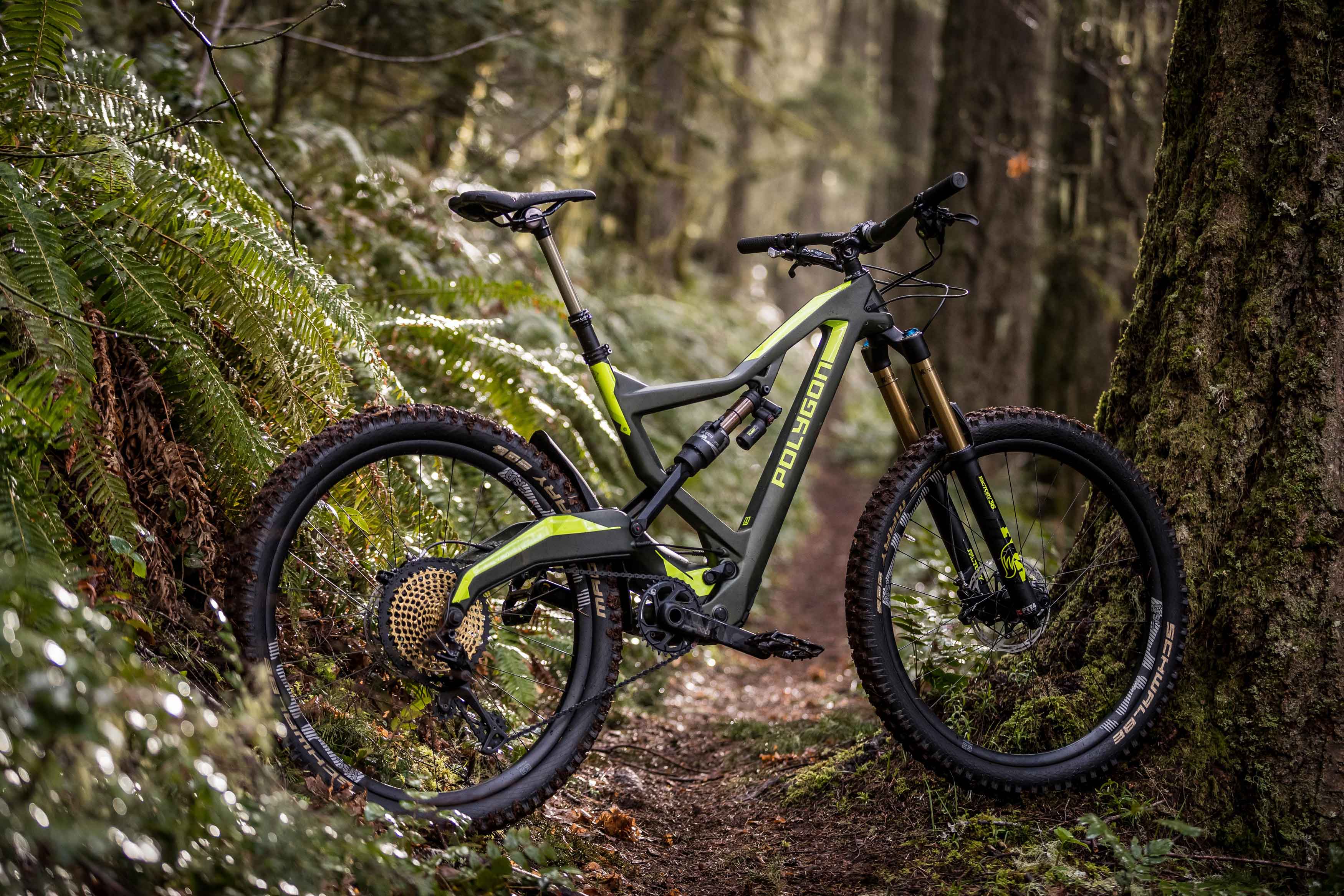
THE PLATFORM
If we were to continue exploring Voss’s long list of accomplishments we’d fall asleep before getting to the new stuff. This is the stuff that has changed how I look at bikes and how to categorize them. A concept nearly 20 years in the making, Voss has been amassing knowledge and experience, which culminate in this unique handling bike design. A nod to Newton’s third law (For every action, there is an equal and opposite reaction), Voss has named the suspension system R3ACT (React). Voss’s brand Naild, will be licensing this sliding four-bar design to companies interested in designing revolutionary category-blurring bikes.
Some may ask, how can another modified four-bar design be so revolutionary, besides the visual difference of elevated chainstays? I asked Darrell just what made his bike ride so much differently than any other bike I’d ridden, and even though I’ve learned Voss in incapable of giving a short or direct answer, I’ve done my best to summarize it into a few key points.
GROUND TRACING AND FORWARD PROPULSION “I wanted to look at designing a bike from the ground up instead of the top down. I wanted the wheel to trace the ground and be able to move up, out of the way while driving back down on the backside of obstacles, which will accelerate the bike and rider,” Voss told me. He continued, “Others have used sliding systems like Maverick, but ours differs as it uses a single stanchion rather than modifying the front triangle to move the sliding portion of the ‘links.’ We placed the sliding element within the swingarm, this provides improved stability of the IC, better stiffness transfer between front and back frame structures while generating a fulcrum with the link that acts like a control cam throughout the travel.
“The primary link, which in my definition, is the link that is primarily in alignment with chain load throughout the range of motion, is like a Canfield, DW and many other type links as it travels in motion with the chain. My secondary link in this case, is connected below the primary link, whereas most are above. In my opinion, when you put the link above, there is tension on the link while pedaling, but when you brake it pulls apart. It’s a varying tension-compression system. Think of it like electricity, all bikes are currently Alternating Current (AC) where my bike is Constant Current (or DC). Naild bikes keep compression loads stacked in the same direction so you never have one side of the frame under compression while the other is under tension. Think of your links when you enter a turn hard on the brakes, one side is pushing and one is pulling. The Naild system has eliminated that with this design.”
KINEMATICS When we moved on to the next topic of kinematics Darrell opened up with a rhetorical question – “Do we need expensive parts on our bikes to have fun? Absofuckinlutely not!” He said. “We need to address this because so many people are trying to make up for shitty kinematic design with expensive shocks and tunes. The big reason testers are loving these bikes so much is that we are able to run almost zero damping in the mid stroke and just let it do the resistance work at the end of the travel!” Voss explained. Darrell views kinematics as the most important part of designing a properly balanced bike and that means using stored potential or active energy and converting it to forward propulsion. What this could mean for end-users is a cheaper and better performing bike—two things Darrell is passionate about. By creating a bike with superior kinematic design Naild is able to get the bike to perform incredibly without a thousand dollar shock.
DAMPING One of the most interesting parts of the R3ACT-equipped bikes is that the shocks have greatly reduced damping needs. They are able to operate with much less damping resistance in the initial 75% of stroke while not blowing through the travel or bottoming out harshly. The design uses shocks that are wide open through the mid-stroke but maintain factory end-of-travel damping. This is achieved through design, and the benefits I felt on trail were very real. I’d never ridden a bike that let the rear wheel get out of the way so quickly. Voss had a theory he shared regarding damping and it’s something he followed while developing the squat and other performance curve of his bikes. “Dampers equal restriction. Restriction equals resistance. Resistance equals friction. Friction equals loss of energy,” he proclaimed. In summary, if people are making up for poor designs by putting more damping into the shocks, all we’re doing is creating more friction, which slows down the rear wheels ability to move out of the way and therefore the rider’s forward momentum.
FUN ON BIKES Over and over throughout the course of this project Darrell has been consumed with how much fun people will have on these bikes. After one of our test sessions when I was trying to put words to the experience I just had he interjected, “Words can never replace the tactile feedback that one experiences on a ride. We will not even try, but my dilemma is how do we let people know what you’re feeling right now!?” This is where my job got even harder.
To bring it back full circle, Darrell Voss is a big man with a big technological advancement in his pocket. Trying to come up with words to describe my time on his prototypes was a very challenging task. The same way we judge people or things based on our previous experiences or what we know, it was hard to craft words to explain on-trail performance I’d never felt before.
I had just pedaled a 180mm bike up a steep, switchbacky XC trail before traversing over to a legitimate DH track littered with rocks the size of bulldogs and several 2- to 5-foot drops. If I were riding with blinders on I’d swear I had two different bikes under me because I couldn’t comprehend how a bike that climbed so smoothly and without perceived “pedal-bob” could tackle the terrain I rode down several times without so much as a hiccup. The bike felt like it had ten inches of travel while plowing over smaller to medium sized obstacles and yet it pedaled like a firm, shorter travel bike with the benefit of the wheel moving over obstacles instead of hitting them. Often times a locked out rear end or shorter travel bike will be a bit harsh on the ass while climbing over sharp-edged rocks or roots, it’s part of the compromise for efficiency. This R3ACT-equipped bike however, had the efficiency I expected from an XC bike yet the compliance of the wheel moving over terrain was what I’d expect from a coil sprung DH bike cruising over Snickers bars.
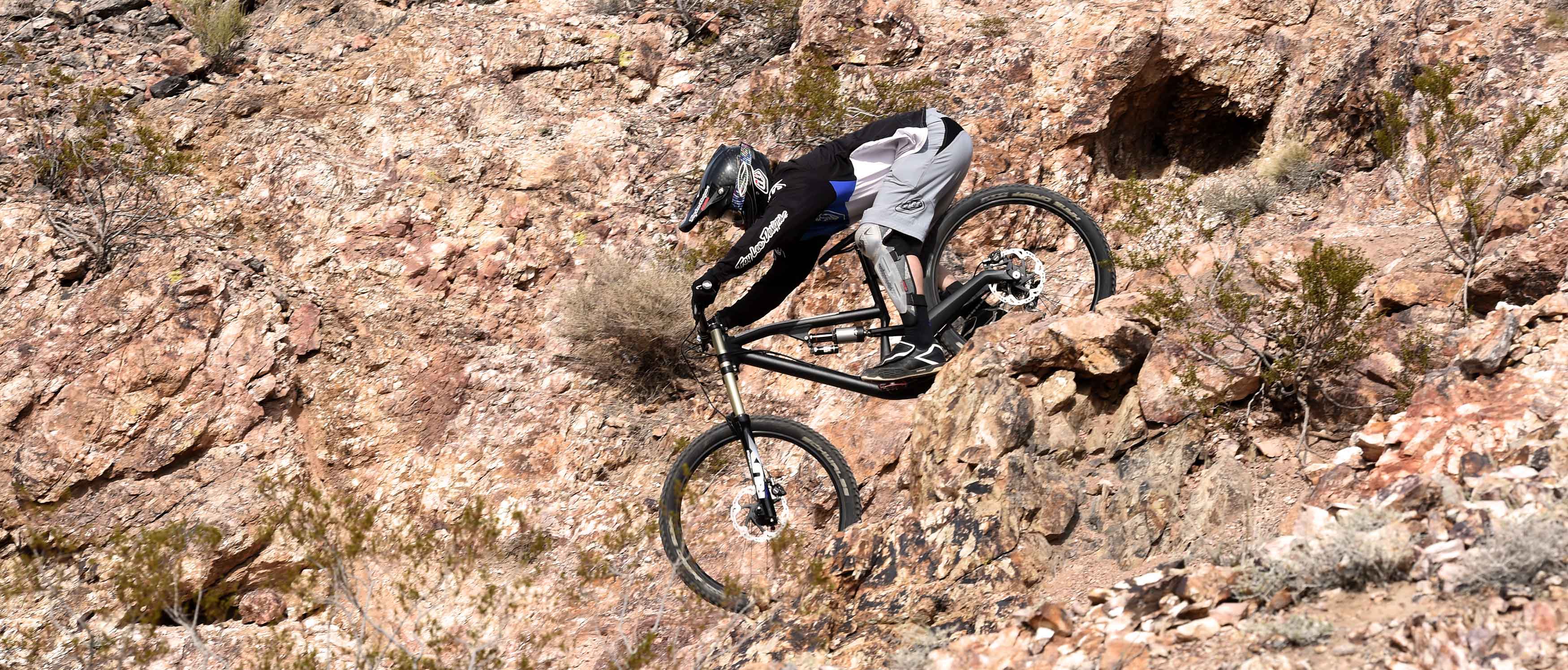
Eric Carter was involved in much of the early testing. Here he is putting an early tester through the ringer at Bootleg Canyon.
WHAT’S NEXT?
From the unpainted prototypes Darrell first showed us in the California desert to the showroom-ready production models we rode in Oakridge, this project has been a wild ride. Finally being able to ride the bikes with other people was a real treat. Up until this point, most of my time spent on these bikes was alone, and under Darrell’s supervision and I’d usually spend the subsequent week wondering if it was really that good or if my memory was building it up. After seeing the faces of all the media guests, Mik Hannah and Kurt Sorge as they looked down at the bikes while riding with that same puzzled look I’ve had for the last three years, I realized I was lucky enough to document and be a part of something big. I’m not talking new tire width or 35mm handlebar big, I mean dropper post big, or hydraulic disc brakes big. NAILD’s R3ACT system is like the Verizon of bike suspension – more performance, more places.
As a bike reviewer, my job has been pretty good the last few years. Modern bikes have come a long ways and it’s become more difficult to really pick out a loser. The brutal reality now is, those same bikes I wrote great reviews about six months ago don’t seem as impressive since I brought home a R3ACT-equipped bike and put it head-to-head on familiar trails. Don’t get it wrong, they’re still good bikes, but, if all you’d eaten was tasty hamburger all your life and someone drops a tenderloin filet in your lap, you’re gonna have a hard time going back. Now that you know how good beef can be, it’s difficult to go back to what you once thought was good. The bike world and the burger now have something in common, they’re both gonna need catch up.
For more info visit: www.naild.it
